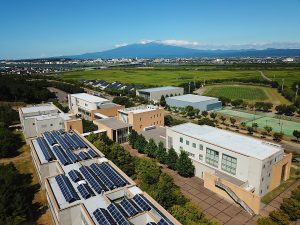Japan has led by the example of resilience and determination to build back better – be it rebuilding from the ruins of war or the fury of nature. It has been 10 years since the Great East Japan Earthquake struck the Tohuku region. The triple disaster – a devastating earthquake with a magnitude of 9.0 off the east coast of Japan, the ensuing tsunami, and subsequent meltdown at the Tokyo Electric Power Company’s Fukushima Daiichi nuclear power plant – posed one of the biggest challenges in Japan’s post-war history.
On that fateful afternoon of March 11, I happened to be in Tokyo. As a visiting doctoral student at the University of Tokyo in 2011, the general library in Hongo campus was practically my home for a year. The present building was constructed in 1928 after the old one was destroyed in the Great Kanto Earthquake in 1923. Grasping the magnitude of the unfolding disaster led to a few anxious moments as tremors and aftershocks shook Tokyo, 231 miles away from the epicenter. But what emerged from that night of uneasy calm was the strength of community resilience that is bound to inspire.
The domestic political conversation dominating the subsequent weeks and months dug deep into gaps in the Kan administration’s crisis management and inconsistencies in information flow with regard to the nuclear accident.
The nuclear accident also marked a defining moment in Japan’s energy debate. Mapping a realistic energy mix option is anchored on 3E+S: economy, energy security, environment, and safety.
In crafting the energy strategy, policymakers are navigating several challenges including limited scope for energy efficiency, Japan’s low energy self-efficiency ratio and dependency on imports, complying with emission standards, offline nuclear reactors, safety upgrades in aging reactors, nuclear waste management, and marshalling public trust in the safety of nuclear reactors.
The Fukushima meltdown underscored the need to undo the power of the “nuclear village” (a web of mutually reinforcing vested interest involving politicians, bureaucrats, business lobbies, and power utilities) diluting accountability and transparency in the regulatory system, and promoting collusive interests pursued through amakudari and amaagari (a reference to the revolving door between government and business employment).
Fukushima unfolded a dynamic discussion on role of nuclear and renewable energy in the future energy matrix as Tokyo is currently reviewing its fifth Strategic Energy Plan. With tight safety requirements in place by the Nuclear Regulatory Authority, 24 out of the 54 reactors operating before the disaster are listed for decommissioning; just nine reactors have restarted. While nuclear energy produced 25.1 percent of electricity in 2010, it contributed around 6 percent in 2020.
Japan witnessed the growth of renewable energy in power generation, reaching 16 percent in 2017. Though modest when compared to some European powers likes Germany, Spain, or Italy. That marks a substantial rise compared to 2010, when renewables accounted for just 9.5 percent of Japan’s power. In advancing renewables, addressing grid constraints, supply stability, operational efficiency, electricity quality, and increasing competition in the market is vital. Reforms are underway in the electricity market.
While complete elimination of nuclear energy from Japan’s electricity mix may be unrealistic, energy officials should seize the opportunity to make tangible efforts to gradually reduce reliance on nuclear power and create space for safer and clean alternative sources.
Japan – as the world’s fifth-largest emitter of carbon dioxide – is striving for a cost-competitive, secure and sustainable energy future, aligned with its commitment to reduce greenhouse gas emissions by 26 percent by 2030 from 2013 levels to achieve the Paris climate target.
Japan’s Green Growth Strategy for Achieving Carbon Neutrality in 2050 categorizes 14 priority fields. It has set the goal for renewable energy accounting for 50-60 percent of electricity demand, with 30-40 percent covered by nuclear and thermal power plants using carbon capture utilization and storage, and 10 percent from hydrogen and ammonia power generation. Japan intends to phase out inefficient coal plants by 2030. The Basic Hydrogen Strategy aims to commercialize hydrogen power generation as well as international hydrogen supply chains and cut the unit hydrogen power generation cost.
Following the triple disaster, regional economic revitalization has remained a priority, and the Tokyo Olympics is pitched as the Recovery and Reconstruction Games. Fukushima itself is emerging as a renewable hub as the prefectural government aims to produce sufficient renewable energy to supply 100 percent of Fukushima’s energy demand by 2040. Namie town, north of the Fukushima facility, hosts the world’s largest renewable hydrogen plant.
The 1970s oil shocks pushed Japan toward energy resource diversification and efficiency, and nuclear energy was pursued as a quasi-indigenous way to augment energy security that aligned well with environmental concerns. But the Fukushima meltdown raised public concerns and presented a chance to rethink on renewables. Feed-in-tariffs (FIT) encouraging investment in renewable energy are in place, but building a consensus on what cost Japan is ready to bear is often challenging as the burden of the power companies is passed on to the consumers. Government estimates indicate that the financial burden on consumers under the FIT program may amount to 4.9 trillion yen in 2030.
The leading countries for public spending on energy R&D in 2018 were the United States, China, Japan, France, and Germany. As Japan pursues its energy and climate ambitions, Tokyo’s innovation and technology prowess will be the driving force in its road to renewables.
Dr. Titli Basu is as associate fellow at The Manohar Parrikar Institute for Defence Studies and Analyses, India.
































